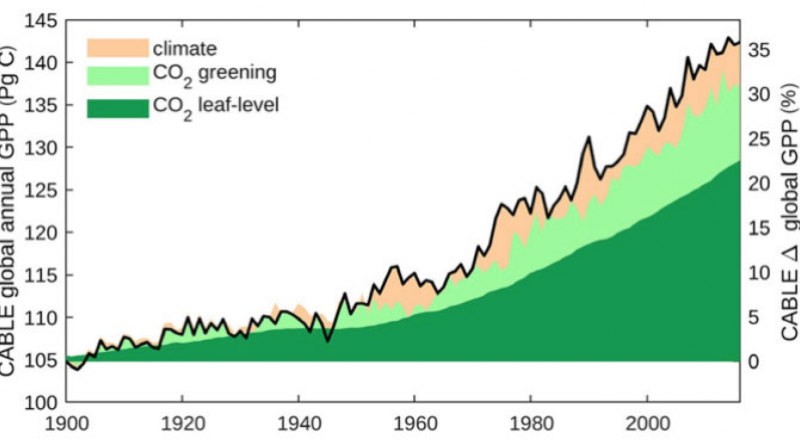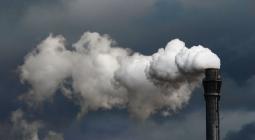Greening the planet and slouching towards Paris?

A new paper finds higher than expected CO2 fertilization inferred from leaf to global observations. The paper predicts that the Earth is going to gain nearly three times as much green matter as was predicted by the IPCC AR5.
Earlier this month, I posted a short piece about an explosive paper on planetary greening that appeared in the journal Global Change Biology. I’ve since mused that it deserves a considerably longer, more contextual post.
The innocuously titled paper, “Higher than expected CO2 fertilization inferred from leaf to global observations”, by Vanessa Haverd (of Australia’s CSIRO) and eight coauthors uses a biophysical model and observed climate to back-calculate global primary productivity (GPP; the net change in standing vegetation per year), and to forward-calculate it using climate model forecasts.
Abstract. “Several lines of evidence point to an increase in the activity of the terrestrial biosphere over recent decades, impacting the global net land carbon sink (NLS) and its control on the growth of atmospheric carbon dioxide (ca). Global terrestrial gross primary production (GPP)—the rate of carbon fixation by photosynthesis—is estimated to have risen by (31 ± 5)% since 1900, but the relative contributions of different putative drivers to this increase are not well known. Here we identify the rising atmospheric CO2 concentration as the dominant driver. We reconcile leaf‐level and global atmospheric constraints on trends in modeled biospheric activity to reveal a global CO2 fertilization effect on photosynthesis of 30% since 1900, or 47% for a doubling of ca above the pre‐industrial level. Our historic value is nearly twice as high as current estimates (17 ± 4)% that do not use the full range of available constraints. Consequently, under a future low‐emission scenario, we project a land carbon sink (174 PgC, 2006–2099) that is 57 PgC larger than if a lower CO2 fertilization effect comparable with current estimates is assumed. These findings suggest a larger beneficial role of the land carbon sink in modulating future excess anthropogenic CO2 consistent with the target of the Paris Agreement to stay below 2°C warming, and underscore the importance of preserving terrestrial carbon sinks.”
The paper predicted that the earth is going to gain nearly three times as much green matter as was forecast in the last (2013) IPCC report. It is noteworthy that Haverd’s model very faithfully reproduced the satellite-sensed changes in leaf area index shown by Zhu et al. (2016), which found the greatest greenings to be in the world’s semiarid tropics, tropical forests, and a smaller (but significant) increase in temperate latitudes. (I noted that paper here in 2018).
It’s very reassuring when two radically different methods—satellite sensing (Zhu) and a biophysical model (Haverd) come up with pretty much the same answer: we are greening up the earth fast, especially in critical tropical ecosystems.
Under a plausible emissions pathway, this will pull so much carbon dioxide out of the air that we could meet the Paris Accord of keeping surface warming below 2⁰C. Specifically, the authors wrote,
“[t]hese findings suggest a larger beneficial role of the land carbon sink in modulating future excess anthropogenic CO2 consistent with the target of the Paris Agreement to stay below 2°C warming…”
But they leave it the reader to do the math to see just how much their findings move the world toward Paris (which of course I will do later in this post).
Here are the amounts and causes of changes in past GPP:

Figure 1. Historical annual GPP according Haverd et al. Plotted here are the effects of leaf-level physiological changes directly stimulated by carbon dioxide (dark green), the overall increase in leaf matter i(light green), and the effects of climate change (tan)—i.e. the increase in temperature since 1900.
Haverd et al. give the previously accepted 1900-2006 increase in GPP as 17% +/- 4%. They used a model with land use, observed climate, and an interaction between changing CO2 and climate and found GPP likely increased 31%+/- 4%, or statistically speaking, roughly twice the increase in planetary green-ness that was previously accepted.

Figure 2. The left-hand image is Haverd et al’s map of model-calculated trends in Global Primary Productivity (the units are grams of carbon per meter squared per year), for 1980-2016. The right figures break down the causes: direct carbon dioxide effect (C), temperature effect (T), the interaction between the two (CxT), precipitation (P) and land use change (LUC). Of most interest here is the left-hand image which is very similar to Zhu et al’s satellite greening.
Obviously, if increasing atmospheric carbon dioxide caused so much planetary greening in 1980-2016 (Figure 2), it stands to reason that there’s going to be a much bigger change during the remainder of this century. Using a similar approach to what they applied to the past (but now climate forecasts are substituted for observations), they estimated the increase in green-ness that would result from either doubling atmospheric carbon dioxide from its preindustrial background, or putting the world on a low-emission pathway in which its concentration peaks at 440 parts per million (ppm) around 2050. (For reference, the annual average for 2020 is likely to be around 410ppm). The emissions scenario in Haverd is the UN’s Representative Concentration Pathway (RCP) 2.6, their lowest one.
University of Guelph Economist Ross McKitrick recently demonstrated that global carbon dioxide concentrations have been below every UN scenario generated from the 1990s onward, so the lower-peaking scenario isn’t just fantasy. (My own opinion, consistent with many others, is that we are currently running around RCP 6.0.)
In the doubling scenario (from a nominal 300 to 600ppm) they project a whopping 47% increase in green biomass from 2006-2099. That’s over and above the 37% increase already observed since 1900 (Figure 1). So we are going to come darned close to doubling the earth’s green vegetation since 1900 with no particular conservation effort. Doubling of the CO2 concentration (relative to preindustrial) will likely occur sometime around 2070 or so.
The changes in green matter increase projected for 2006-2099 using RCP 2.6 are still huge. Read their words (and I hope your sitting down): “…we estimate a cumulative biophysical sink…equivalent to 17 years of anthropogenic emissions at current rates [emphasis added].
RCP 2.6 is associated with 2.4⁰C of warming (since preindustrial) by 2100. The goal of the Paris Agreement is to hold warming to two degrees or below. The reduction in warming from the equivalent of 17 years of zero emissions is, of course, spread through the century, but if it took place now (according to the UN’s models) it would reduce 0.5⁰C of the expected warming. The IPCC models have us warming at roughly 0.3⁰C/decade in the near term, but Haverd et al. tell us we will effectively have 1.7 decades of zero emissions thanks to greening.
A little math: 2.4⁰ (the UN’s expected RCP 2.6 warming to 2100) minus 0.5⁰ (the reduction in warming from 17 years of zero emissions) = 1.9⁰C of warming. Thanks to the wonders of photosynthesis on God’s getting-greener earth, we meet the Paris Accord.
That should have been front-page news. Instead, at least according to google, there hasn’t been one story about this astounding paper.
Moderation note: As with all guest posts, please keep your comments civil and relevant.
14 May 2020
Climate Etc




